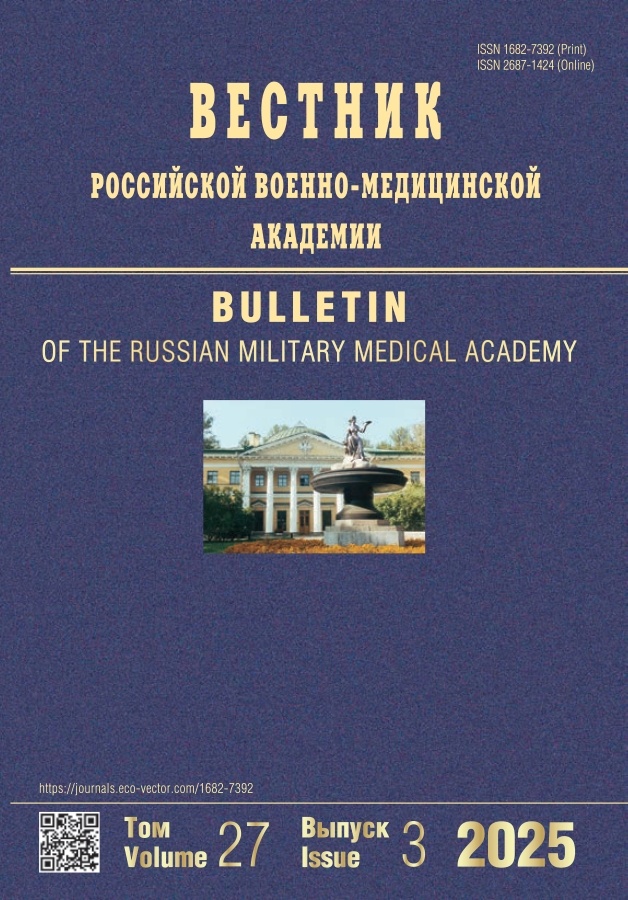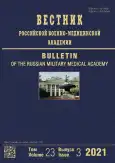Epidemiological aspects of the aortic valve pathology
- 作者: Gordienko A.V.1, Shikhverdiev N.N.1
-
隶属关系:
- Military Medical Academy named after S.M. Kirov of the Ministry of Defense of the Russian Federation
- 期: 卷 23, 编号 3 (2021)
- 页面: 23-28
- 栏目: Clinical trials
- URL: https://journals.rcsi.science/1682-7392/article/view/75942
- DOI: https://doi.org/10.17816/brmma75942
- ID: 75942
如何引用文章
详细
The dynamics of the structure of aortic valve pathology over the thirty-year (1991–2020) period of operation of the cardiac surgery hospital of the first department and the clinic of surgery for advanced training of doctors of the Military Medical Academy named after S.M. Kirov is evaluated. 849 cases of aortic valve replacement were retrospectively studied (626 (74%) men, 223 (26%) women). The average age of the patients was 51.8 ± 9.7 years. It was established that the main causes of aortic valve damage were rheumocarditis, calcified aortic stenosis, infectious endocarditis and congenital heart disease in the form of a bicuspid aortic valve. A significant decrease in the incidence of rheumatism as a cause of aortic malformation was revealed from 36% in the period from 1991 to 2000 to 13% in the period from 2011 to 2020. The frequency of calcified aortic stenosis during this period, on the contrary, increased from 30% to 70%, respectively. At the same time, the relationship between the increase in life expectancy of the population of the Russian Federation and the frequency of occurrence of calcified aortic stenosis is traced. This is due to a long asymptomatic period that characterizes the natural course of this pathology, as a result of which the clinical manifestations of this pathology manifest, as a rule, only in old age. During the study period, an increase in the average age of patients who needed aortic valve replacement was also noted. If in the last decade of the twentieth century. it was 41.5 years, then in the period from 2011 to 2020, the average age of patients who needed aortic valve replacement increased to 61.5 years. Thus, over the past thirty years, there has been a significant change in the structure of the pathology of the aortic valve. Calcified aortic stenosis has become the most common cause of prosthetics of aortic malformation, against the background of a significant decrease in the frequency of rheumatic genesis of aortic valve damage.
作者简介
Alexander Gordienko
Military Medical Academy named after S.M. Kirov of the Ministry of Defense of the Russian Federation
Email: gord503@mail.ru
ORCID iD: 0000-0002-6901-6436
SPIN 代码: 5049-8212
doctor of medical sciences, professor
俄罗斯联邦, Saint PetersburgNizam Shikhverdiev
Military Medical Academy named after S.M. Kirov of the Ministry of Defense of the Russian Federation
编辑信件的主要联系方式.
Email: niznaz@mail.ru
ORCID iD: 0000-0003-2915-3214
SPIN 代码: 8701-7238
adjunct
俄罗斯联邦, Saint Petersburg参考
- Olivetti G, Melissari M, Capasso JM, et al. Cardiomyopathy of the aging human heart. Myocyte loss and reactive cellular hypertrophy. Circ Res. 1991;68(6):1560–1568. doi: 10.1161/01.res.68.6.1560
- Skopin II, Otarov AM. Preoperative risk factors for aortic valve prosthetics in elderly and senile patients. Byulleten’ NCSSKH im. A.N. Bakuleva RAMN. 2017;18(3):243–245. (In Russ.). doi: 10.24022/1810-0694-2017-18-3-243-255
- Rossiiskii statisticheskii ezhegodnik. 2020: Stat. sb. Moscow: Rosstat; 2020. 700 p. (In Russ.).
- Gulyaev NI, Varavin NA, Korovin AE, et al. Modern aspects of the pathogenesis of calcification of aortic half-moons (literature review). Vestnik of Saint Petersburg University. Medicine. 2016;(3):20–34. (In Russ.). doi: 10.21638/11701/spbu11.2016.302
- Thaden JJ, Nkomo VT, Enriquez-Sarano M. The global burden of aortic stenosis. Prog Cardiovasc Dis. 2014;56(6):565–571. doi: 10.1016/j.pcad.2014.02.006
- Shostak NA, Karpova NY, Rashid MA, et al. Calcified aortic stenosis of degenerative genesis-clinical and instrumental indicators. Russian Journal of Cardiology. 2006;11(5):40–44. (In Russ.).
- Woldu B, Bloomfield GS. Rheumatic heart disease in the twenty-first century. Curr Cardiol Rep. 2016;18(10):96. doi: 10.1007/s11886-016-0773-2
- Leal MTBC, Passos LSA, Guarçoni FV, et al. Rheumatic heart disease in the modern era: recent developments and current challenges. Rev Soc Bras Med Trop. 2019;52:e20180041. doi: 10.1590/0037-8682-0041-2019
- Clavel MA, Pibarot P. A decade of revolutions in calcific aortic stenosis. Cardiol Clin. 2020;38(1):13–14. doi: 10.1016/j.ccl.2019.10.001
- Harris AW, Pibarot P, Otto CM. Aortic stenosis: guidelines and evidence gaps. Cardiol Clin. 2020;38(1):55–63. doi: 10.1016/j.ccl.2019.09.003
- Lindman BR, Clavel MA, Mathieu P, et al. Calcific aortic stenosis. Nat Rev Dis Primers. 2016;2:16006. doi: 10.1038/nrdp.2016.6
- Roth GA, Huffman MD, Moran AE, et al. Global and regional patterns in cardiovascular mortality from 1990 to 2013. Circulation. 2015;(132):1667–1678. doi: 10.1016/j.jacc.2017.04.052
- Frieden TR, Cobb LK, Leidig RC, et al. Reducing premature mortality from cardiovascular and other non-communicable diseases by one third: achieving sustainable development goal indicator 3.4.1. Glob Heart. 2020;15(1):50. doi: 10.5334/gh.531
- Rajput FA, Zeltser R. Aortic valve replacement. In: StatPearls [Internet] Treasure Island (FL): StatPearls Publishing. 2020. Available from: https://www.ncbi.nlm.nih.gov/books/NBK537136/
- Bashir M, Harky A, Bleetman D, et al. Aortic valve replacement: are we spoiled for choice? Semin Thorac Cardiovasc Surg. 2017;29(3):265–272. doi: 10.1053/j.semtcvs.2017.08.003
- Liu M, Lu L, Sun R. Rheumatic heart disease: causes, symptoms, and treatments. Cell Biochem Biophys. 2015;72(3):861–863. doi: 10.1007/s12013-015-0552-5
- Shikhverdiev NN, Ushakov DI, Peleshok AS, et al. Biological age and its role in the stratification of cardiac surgical risk. Grekov’s Bulletin of Surgery. 2019;178(1):17–20. (In Russ.). doi: 10.24884/0042-4625-2019-178-1-17-20
补充文件








